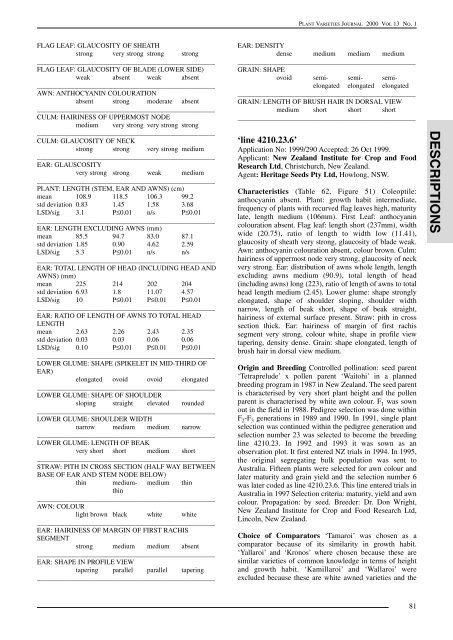53. Volume 13- Number 1 - IP Australia
53. Volume 13- Number 1 - IP Australia
53. Volume 13- Number 1 - IP Australia
You also want an ePaper? Increase the reach of your titles
YUMPU automatically turns print PDFs into web optimized ePapers that Google loves.
DESCR<strong>IP</strong>TIONS<br />
PLANT VARIETIES JOURNAL 2000 VOL <strong>13</strong> NO. 1<br />
FLAG LEAF: GLAUCOSITY OF SHEATH<br />
strong very strong strong strong<br />
____________________________________________________<br />
FLAG LEAF: GLAUCOSITY OF BLADE (LOWER SIDE)<br />
weak absent weak absent<br />
____________________________________________________<br />
AWN: ANTHOCYANIN COLOURATION<br />
absent strong moderate absent<br />
____________________________________________________<br />
CULM: HAIRINESS OF UPPERMOST NODE<br />
medium very strong very strong strong<br />
____________________________________________________<br />
CULM: GLAUCOSITY OF NECK<br />
strong strong very strong medium<br />
____________________________________________________<br />
EAR: GLAUSCOSITY<br />
very strong strong weak medium<br />
____________________________________________________<br />
PLANT: LENGTH (STEM, EAR AND AWNS) (cm)<br />
mean 108.9 118.5 106.3 99.2<br />
std deviation 0.83 1.45 1.58 3.68<br />
LSD/sig 3.1 P≤0.01 n/s P≤0.01<br />
____________________________________________________<br />
EAR: LENGTH EXCLUDING AWNS (mm)<br />
mean 85.5 94.7 83.0 87.1<br />
std deviation 1.85 0.90 4.62 2.59<br />
LSD/sig 5.3 P≤0.01 n/s n/s<br />
____________________________________________________<br />
EAR: TOTAL LENGTH OF HEAD (INCLUDING HEAD AND<br />
AWNS) (mm)<br />
mean 225 214 202 204<br />
std deviation 6.93 1.8 11.07 4.57<br />
LSD/sig 10 P≤0.01 P≤0.01 P≤0.01<br />
____________________________________________________<br />
EAR: RATIO OF LENGTH OF AWNS TO TOTAL HEAD<br />
LENGTH<br />
mean 2.63 2.26 2.43 2.35<br />
std deviation 0.03 0.03 0.06 0.06<br />
LSD/sig 0.10 P≤0.01 P≤0.01 P≤0.01<br />
____________________________________________________<br />
LOWER GLUME: SHAPE (SPIKELET IN MID-THIRD OF<br />
EAR)<br />
elongated ovoid ovoid elongated<br />
____________________________________________________<br />
LOWER GLUME: SHAPE OF SHOULDER<br />
sloping straight elevated rounded<br />
____________________________________________________<br />
LOWER GLUME: SHOULDER WIDTH<br />
narrow medium medium narrow<br />
____________________________________________________<br />
LOWER GLUME: LENGTH OF BEAK<br />
very short short medium short<br />
____________________________________________________<br />
STRAW: PITH IN CROSS SECTION (HALF WAY BETWEEN<br />
BASE OF EAR AND STEM NODE BELOW)<br />
thin medium- medium thin<br />
thin<br />
____________________________________________________<br />
AWN: COLOUR<br />
light brown black white white<br />
____________________________________________________<br />
EAR: HAIRINESS OF MARGIN OF FIRST RACHIS<br />
SEGMENT<br />
strong medium medium absent<br />
____________________________________________________<br />
EAR: SHAPE IN PROFILE VIEW<br />
tapering parallel parallel tapering<br />
____________________________________________________<br />
EAR: DENSITY<br />
dense medium medium medium<br />
____________________________________________________<br />
GRAIN: SHAPE<br />
ovoid semi- semi- semielongated<br />
elongated elongated<br />
____________________________________________________<br />
GRAIN: LENGTH OF BRUSH HAIR IN DORSAL VIEW<br />
medium short short short<br />
____________________________________________________<br />
‘line 4210.23.6’<br />
Application No: 1999/290 Accepted: 26 Oct 1999.<br />
Applicant: New Zealand Institute for Crop and Food<br />
Research Ltd, Christchurch, New Zealand.<br />
Agent: Heritage Seeds Pty Ltd, Howlong, NSW.<br />
Characteristics (Table 62, Figure 51) Coleoptile:<br />
anthocyanin absent. Plant: growth habit intermediate,<br />
frequency of plants with recurved flag leaves high, maturity<br />
late, length medium (106mm). First Leaf: anthocyanin<br />
colouration absent. Flag leaf: length short (237mm), width<br />
wide (20.75), ratio of length to width low (11.41),<br />
glaucosity of sheath very strong, glaucosity of blade weak.<br />
Awn: anthocyanin colouration absent, colour brown. Culm:<br />
hairiness of uppermost node very strong, glaucosity of neck<br />
very strong. Ear: distribution of awns whole length, length<br />
excluding awns medium (90.9), total length of head<br />
(including awns) long (223), ratio of length of awns to total<br />
head length medium (2.45). Lower glume: shape strongly<br />
elongated, shape of shoulder sloping, shoulder width<br />
narrow, length of beak short, shape of beak straight,<br />
hairiness of external surface present. Straw: pith in cross<br />
section thick. Ear: hairiness of margin of first rachis<br />
segment very strong, colour white, shape in profile view<br />
tapering, density dense. Grain: shape elongated, length of<br />
brush hair in dorsal view medium.<br />
Origin and Breeding Controlled pollination: seed parent<br />
‘Tetraprelude’ x pollen parent ‘Waitohi’ in a planned<br />
breeding program in 1987 in New Zealand. The seed parent<br />
is characterised by very short plant height and the pollen<br />
parent is characterised by white awn colour. F 1 was sown<br />
out in the field in 1988. Pedigree selection was done within<br />
F 2 -F 3 generations in 1989 and 1990. In 1991, single plant<br />
selection was continued within the pedigree generation and<br />
selection number 23 was selected to become the breeding<br />
line 4210.23. In 1992 and 1993 it was sown as an<br />
observation plot. It first entered NZ trials in 1994. In 1995,<br />
the original segregating bulk population was sent to<br />
<strong>Australia</strong>. Fifteen plants were selected for awn colour and<br />
later maturity and grain yield and the selection number 6<br />
was later coded as line 4210.23.6. This line entered trials in<br />
<strong>Australia</strong> in 1997 Selection criteria: maturity, yield and awn<br />
colour. Propagation: by seed. Breeder: Dr. Don Wright,<br />
New Zealand Institute for Crop and Food Research Ltd,<br />
Lincoln, New Zealand.<br />
Choice of Comparators ‘Tamaroi’ was chosen as a<br />
comparator because of its similarity in growth habit.<br />
‘Yallaroi’ and ‘Kronos’ where chosen because these are<br />
similar varieties of common knowledge in terms of height<br />
and growth habit. ‘Kamillaroi’ and ‘Wallaroi’ were<br />
excluded because these are white awned varieties and the<br />
81

















